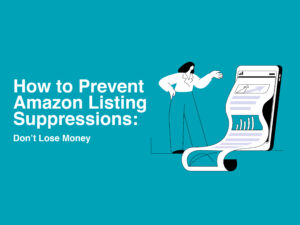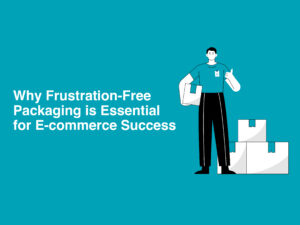Amazon’s advertising landscape is evolving faster than ever. As sellers, we face a constant barrage of new features, algorithm updates, and consumer trends. But fear is not! With the right Amazon advertising strategies in your arsenal, you can stay ahead of the curve, dominate the competition, and skyrocket your sales in the coming year.
Let’s delve into Amazon Advertising Strategies for 2024.
1. Improve Brand Awareness
Amazon is the global leader in retail sales and advertising, making it an ideal platform for sellers to boost sales. One of the driving forces behind this success is Amazon’s Sponsored Brands advertising, which is revolutionizing the way brands are perceived.
Sponsored Brand ads are prominently placed at the top of the search results page, making them incredibly impactful. With custom creative images and the ability to highlight multiple products, Sponsored ads increase brand awareness and have a remarkable sales conversion rate of 18%.
If you’re looking to boost your sales and reach a wider audience, Sponsored Brand ads are the perfect solution. By combining these ads with targeted keyword phrases, you can reach your ideal customers and increase your chances of making a sale. Don’t miss out on this unique opportunity that Amazon offers. Take advantage of Sponsored Brand ads to improve your brand awareness, reach your target audience, and increase your sales.
2. Focus on Product Profitability
One important aspect of planning your Amazon ad campaigns is to focus on the profitability of your products. It might seem trivial, but analyzing the unique selling data points of each SKU, including the cost to promote and the manufacturing and selling costs, can help you determine the profit margins of your products.
Before investing more in paid ads, it’s essential to identify which of your products has a higher profit margin. This way, you can avoid wasting money on ads that won’t yield a worthwhile return.
3. Know Your Advertising Cost of Sales Metrics
Everyone wants to make a lot of sales, but have you considered the cost? As Amazon’s marketplace becomes more competitive, the difference between profitability and a black hole of advertising spend can be a matter of pennies.
It’s essential to understand your Advertising Cost of Sales (ACoS) before launching your ad campaigns. A precise ACoS will help you to establish a sustainable ad budget.
ACoS measures your advertising campaign’s overall efficiency and represents the percentage ratio of ad spend to ad revenue.
You can calculate your Advertising Cost of Sales with this formula:

Your break-even ACoS is the point where your advertising cost equals your profit margin after all fees and costs involved with selling on Amazon are subtracted. Once you’ve determined your target profit margin, subtract it from the break-even ACoS to determine your target ACoS. It’s important to note that a low ACoS isn’t always better. An ad campaign with a higher ACoS may be better at driving traffic higher up in the marketing funnel, especially if you’re launching a new Amazon product.
Suppose you are launching a new product on Amazon. In that case, you would want to get as many people as possible to notice it. An ad campaign with a higher ACoS may be more effective at driving traffic toward your product higher up in the marketing funnel.
4. Use Negative Keywords and Phrases
If you’re selling products on Amazon, it’s important to keep in mind that ad campaigns may not always relate to the intended search terms. To avoid confusing product matches, it’s recommended to use negative keywords and phrases. This will help ensure that your product doesn’t show up in irrelevant search results.
For example, if you’re selling Black Sneakers, targeting Nubuck shoes as a keyword would be counterproductive. Instead, focus on specific keywords and phrases with high conversion rates, while eliminating broad terms that are high-traffic and low-conversion.
Creating a strategy that targets converting keywords and excludes those that don’t is key to utilizing negative keywords effectively. Also, remember to review negations when adding products to your catalog to prevent blocks and avoid competing against your own campaigns.
To increase your ad dollar return, utilize a strategy that focuses on utilizing negative keywords effectively. By using negative keywords, you can adjust the amount you spend on your bids and focus on high-volume, converting words with higher bids while lowering your bid amount on broad, low-converting terms. This will help your product appear more relevant to exact match results while also allowing you to have a smaller presence for any broad terms that may crossover with your keywords.
You can also fine-tune your PPC ads by utilizing the data of keywords that are converting for you. Use the search results that customers find your product with and build your negative keyword list to exclude those terms that drain your budget without converting any sales. Remember, taking the time to fine-tune your PPC ads can help you achieve your ultimate goal of selling your product.
5. Optimizing Ad Campaigns
When it comes to Amazon ads, advertisers have the option to use manual or automatic targeting. While having more control as the advertiser is usually better, there are certain situations where using auto-targeting can be beneficial. Automatic campaigns are particularly useful for conducting broad search term research for a new product and capturing rare ad placements at a low ACoS using low bid autos campaigns. Therefore, it’s important to consider using both manual and automatic targeting to achieve the best results for your Amazon ad campaign.
6. Understanding of Match Types
When it comes to advertising on Amazon, utilizing different match types can make a significant impact on the success of your campaigns. Amazon offers four different match types, including broad, phrase, exact, and negative match. Each of these match types has its own unique benefits and uses.
Board Match Keywords
Broad match is the most general match type. It allows you to target a wide range of keywords and search terms. While broad match is less targeted than other match types, it can be useful for driving traffic to your product pages and increasing brand awareness.
Phrase Match Keywords
Phrase match is more defined than broad match. With phrase match, your ad will only be shown to users who search for specific phrases that contain your targeted keywords in the order you specify. For example, if you sell headphones and your phrase match keyword is “red headphones,” your ad may show up for search terms like “best red headphones” or “red headphones on sale.” Phrase match is a good option for targeting specific customer search terms.
Exact Match Keywords
The exact match is the most targeted match type. It allows you to target specific search terms that match your exact keywords. This means your ad will only show up for users who search for the exact phrase you’ve specified. An exact match is useful when you want to target a very specific audience or when you want to ensure that your ads are only shown to highly qualified leads.
Negative Match Keywords
Finally, a negative match allows you to exclude specific search terms from your campaigns. This can be useful if you want to avoid showing your ads to users who are searching for irrelevant or unrelated terms. By using a negative match, you can save your ad budget and ensure that your ads are only shown to users who are highly likely to convert.
Utilizing different match types can help you refine your targeting and make your Amazon ad campaigns more effective. By understanding the benefits and uses of each match type, you can choose the best options for your specific needs and goals.
7. Elevate Your Bids Strategy
It’s important to regularly review your keywords and analyze their effectiveness to optimize your bids. However, it’s crucial not to make knee-jerk decisions based on recent data alone. It’s possible that the popularity and usage of keywords and phrases could change over time due to various reasons.
To avoid overreacting to small samples of data, use Automatic Targeting to discover the recent terms your customers are using and test new phrases. If a particular keyword continues to perform well, optimize your product content to match and adjust your ads accordingly.
It’s also important to consider the seasonality of your products and adjust your advertising strategy accordingly. Using Automatic Targeting can help reduce the experimentation and risk associated with trial and error in optimizing your bids.
How to avoid risk while optimizing your bids?
Optimizing your bids on Amazon requires a comprehensive approach that involves analyzing historical data, testing new keywords, and managing risk. While it’s important to experiment with new keywords, it’s also crucial to avoid making snap decisions based on recent trends alone.
One effective way to optimize your bids is to use Automatic Targeting, which enables you to discover recent search terms that customers are using. By gradually testing new keywords and evaluating their effectiveness over time, you can identify which ones are performing well and adjust your strategy accordingly.
8. Boost Your Sales with Amazon Sponsored Display Ads
Amazon Sponsored Display Ads are an advertising solution that allows brands with Amazon Brand Registry to target and retarget shoppers on and off Amazon with auto-generated, product-focused ads. Sponsored Display Ads differ from Sponsored Product and Sponsored Brand ads in that they target customers based on their shopping habits instead of keywords. These ads use intuitive, retail-centric controls that are tailored to your brand and product’s specific requirements.
Sponsored Display Ads can appear on specific detail pages, Amazon’s home page, and third-party apps and websites, making them a versatile option for reaching a wide audience. Using these ads, brands can attract audiences while they are browsing, which can lead to increased impressions and clicks on their listings.
One key advantage of Sponsored Display Ads is that they are priced on a vCPM (cost per thousand viewable impressions) basis rather than CPC (cost-per-click) billing. This pricing model can be particularly beneficial for brands whose customers frequently interact with their products multiple times before making a purchase.
According to Amazon, sellers who use Sponsored Display Ads have twice the impressions and half again as many clicks on their listings compared to those who do not. This makes Sponsored Display Ads a potentially valuable addition to any brand’s advertising strategy.
9. Monitor your Ineffective Campaigns
As a marketer, it is important to keep a close eye on your ad campaigns and monitor their performance regularly. After analyzing the metrics and data of your best-performing ad campaigns, it’s time to take action on those that are not performing well. This step is crucial for optimizing your marketing strategy and getting the best possible results.
One of the most effective ways to do this is to monitor the performance of the keywords you are targeting. If certain keywords are not generating enough clicks or conversions, it may be time to remove them from your campaign. This will help you focus your budget on the keywords that are driving the most traffic and sales.
Another important factor to consider is the performance of your products. If a particular product is not selling well, despite significant advertising efforts, it may be time to reevaluate whether it’s worth continuing to promote it. In some cases, it may make sense to discontinue the product altogether, or to consider it as a potential upsell rather than a dedicated product with a marketing budget that is draining funds away from other better-performing products.
Ultimately, by carefully analyzing your ad campaigns and product performance, you can make informed decisions about where to allocate your marketing budget for the best possible return on investment.
10. Turn Insights into Action, Fuel Your Marketing Strategy with Data
To effectively market your products on Amazon, it is essential to continuously analyze your data and make incremental adjustments to your campaigns over time. Even if you are using the best-performing strategies, failing to adapt your campaigns can be a costly mistake. Setting a budget and establishing keywords is only the first step; you need to keep up with the ever-changing landscape of search terms and customers’ search habits.
Therefore, it is crucial to analyze your data regularly to see what’s working and what’s not. You should download reports of effective and performing keywords to eliminate those that cost you money but don’t convert. You should also keep testing and iterating ads to determine the best-performing keywords and terms. This process will involve identifying specific terms that work better, optimizing content and ads to include them more frequently, and using long-tail keyword phrases, which act similarly to exact match type ads.
Remember, advertising on Amazon is a powerful way to increase brand awareness and sales, but it requires a thoughtful and strategic approach. There’s no magic potion to make it happen, but with a robust and data-driven Amazon advertising strategy, you can achieve your goals and grow your business.
At Scoop Global, we understand the importance of building effective strategies that align with your unique business needs. Our team of experts can help you leverage your Amazon advertising, analyze your data, and make the necessary adjustments to keep up with the changing landscape of search terms and customer behavior. By working with us, you can get more out of your Amazon advertising and do more for your business.


